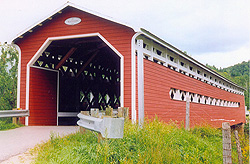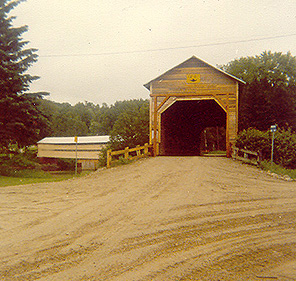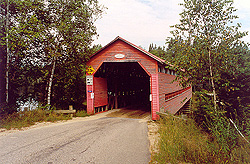(Continued from Part 1)
COVERED BRIDGES IN QUEBEC
Today in the province of Quebec, four basic types of covered bridge design have survived. These are the Town, Howe, Multiple Kingpost (unpatented), and McCallum designs. Examples of the Multiple Kingpost (3) and the Howe truss (2) survive in Quebec only in the Eastern Townships, while the world’s only surviving McCallum bridge may be seen in Powerscourt, in the Châteauguay Valley. 
MINISTRY OF COLONIZATION
The most common type of covered bridge in Quebec is the Town truss or lattice, patented by Ithiel Town in 1820. The vast majority of Quebec’s covered bridges are of the Town lattice design. This is true of bridges in Abitibi, Gaspé, and all other parts of the province, including the Laurentians. The reason for this is simple. When the government of Quebec created its Ministry of Colonization and Mines in the 1890s, with an eye to opening up vast new regions of the province to settlement, it was this department that  built the large majority of the province’s roads and bridges after that date. And from the outset, government engineers opted for one covered bridge design: the Town lattice.
built the large majority of the province’s roads and bridges after that date. And from the outset, government engineers opted for one covered bridge design: the Town lattice.
The design was considered fairly simple to build, and, given the province’s unlimited supply of timber, reasonably economical. The Ministry did, however, introduce a number of important modifications to Town’s original patent, including the use of metal nails instead of wooden pegs, reducing the dimensions of the timbers, and adding metal tension rods and vertical posts.(1) Quebec’s version of the Town truss is sometimes referred to as the “Town Variant”.
 COVERED BRIDGES IN THE LAURENTIANS
COVERED BRIDGES IN THE LAURENTIANS
The surviving covered bridges in the Laurentians make for an interesting tour, and offer some wonderful opportunities to explore the back roads of the Upper Laurentians. The bridges are as follows:
1) Town of Brébeuf. Chemin du Pont-Prud’homme. Du Diable River. 1 span. 44.2 metres (145 feet). Town truss. Date: 1918. [World Guide No. 61-72-01].
2) Town of La Macaza. Chemin du Pont-Couvert. Macaza River. 1 span. 39.3 metres (129 feet). Town truss. Date: 1904. [World Guide No. 61-33-10].
3) Town of Saint-Aimé du Lac-des-îles. Chemin de Ferme Rouge. Du Lièvre River. 2 spans. 49.4 metres (162 feet). Town truss. Date: 1903. One of 2 “twin” bridges. Recognized historic monument. [World Guide No. 61-33-02].
4) Town of Saint-Aimé du Lac-des-îles. Chemin de Ferme Rouge. Du Lièvre River. 2 spans. 76.5 metres (251 feet). Town truss. Date: 1903. One of 2 “twin” bridges. Recognized historic monument. [World Guide No. 61-33-03].
5) Town of Chute-Saint-Philippe. Chemin du Vieux-Pont. Kiamika River. 1 span. 34.7 metres (114 feet). Town Truss. Date: 1906. [World Guide No. 61-33-05].
NOTE: A number of covered bridges are situated in the adjacent Outaouais Region, including a large one at Grand-Remous, northwest of Mont-Laurier. There is also a covered bridge in Berthierville, in the Lanaudière Region.
Reference:1) Société québécoise des ponts couverts, Les Ponts Rouges du Québec, 1999, 9-10.